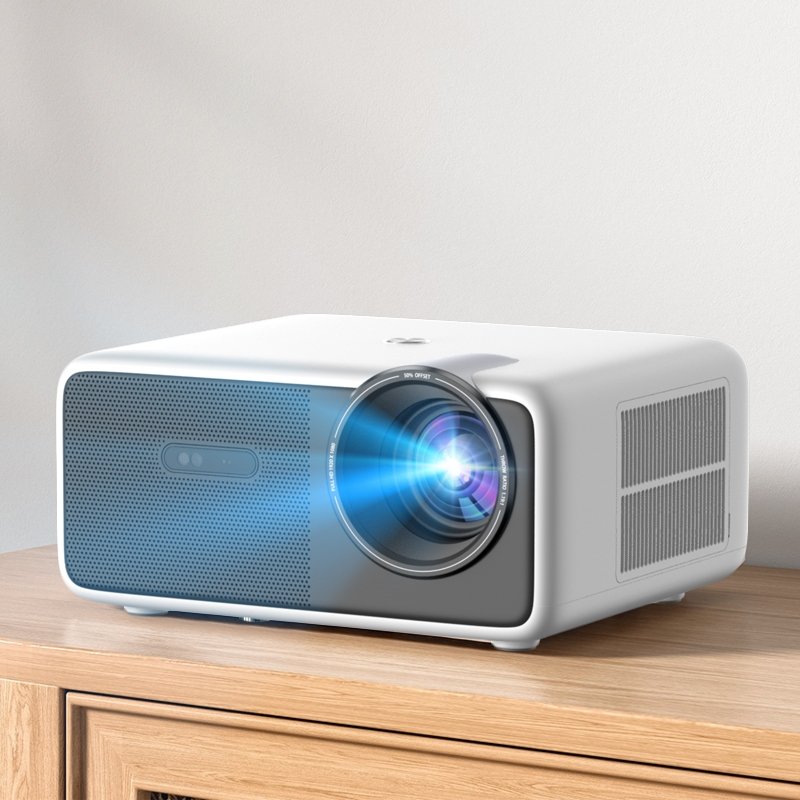LCD projector, short for Liquid Crystal Display Projector, is a type of projection device that uses liquid crystal technology. Its main purpose is to project images or videos onto a screen or other flat surface. This projector presentation equipment consists of three liquid crystal panels, with each panel handling one primary color (red, green, blue). By controlling the brightness and color of these three colors, it can produce high-quality, colorful images.
Liquid crystal is a special material with the ability to change light transmittance under the influence of an electric field. The LCD projector achieves image projection by adjusting the light transmittance of each pixel through liquid crystals. A typical LCD projector system includes a light source (usually a high-brightness incandescent lamp or LED), an optical system passing through the LCD panels, and an electronic control unit for adjusting color and brightness.
Compared to other projection technologies like DLP or LCoS, LCD projector 1080p are generally considered to have advantages in color reproduction and detail display. They perform well in high definition and color accuracy, making them widely used in applications that require fine images and true colors, such as education, business presentations, and home theaters.
In summary, LCD projectors, employing liquid crystal technology, deliver high-quality image projection and are a popular choice for various projection needs.
The Superiority of LCD Projectors in Color and Detail Display
Compared to other projection technologies like DLP or LCoS, LCD projectors are generally considered to have some advantages in color reproduction and detail display, which can positively impact the user experience:
Color Accuracy:
LCD projectors use three liquid crystal panels, each controlling a primary color (red, green, blue). This design allows for more accurate reproduction of real-world colors, providing fuller and more vivid images.
In contrast to some DLP projectors that may exhibit the rainbow effect, LCD smart mini projector offer more stable color performance, reducing the likelihood of visual fatigue and enhancing the viewing experience.
Clarity in Detail Display:
LCD projectors typically excel in displaying fine details. Due to the characteristics of liquid crystal technology, projector 4k home theater can deliver higher resolution and image clarity, allowing audiences to see subtle details more clearly.
When projecting complex scenes and high-contrast images, LCD projectors often maintain clarity in details, minimizing distortion or blurring.
Representation of Color Gradation and Depth:
LCD projectors generally excel in representing color gradients and depth. This is crucial for showcasing complex color tones and shadows in images or videos, providing audiences with a more comprehensive and realistic visual experience.
When handling dark details, LCD projectors maintain high color accuracy without the risk of color distortion or loss of deep details.
In summary, LCD projectors receive positive feedback for their performance in color reproduction and detail display, making them a preferred choice for applications where image quality is crucial. However, each projection technology has its own strengths and limitations, and the optimal choice depends on the specific needs and use cases of the user.
Why LCD Projectors Shine Bright in Price and Performance
When comparing LCD projectors to other projection technologies, price is also a crucial factor to consider. Although the specific pricing can be influenced by various factors, generally, LCD projectors may have advantages in some aspects:
Cost-Effective Manufacturing:
LCD technology is relatively mature, and the manufacturing process is comparatively straightforward. The production cost of manufacturing LCD 4k portable mini projector may be lower compared to some advanced projection technologies, and this cost efficiency may be reflected in product pricing.
Intense Competition Driving Price Reductions:
The LCD projector market experiences fierce competition, with numerous manufacturers offering various specifications and models. This competitive landscape leads to a trend of decreasing prices, allowing users to purchase LCD projectors bluetooth at relatively lower costs for similar performance.
Diverse Price Ranges:
The LCD projector market provides a wide range of product choices, including models with different performance levels and feature sets. This means users can choose products that fit their budget and requirements, offering greater flexibility in terms of pricing.
Low Maintenance Costs:
Due to the typically longer lamp life and lower maintenance costs of LCD projectors, users can reduce the overall ownership costs over extended periods. This cost advantage is particularly beneficial when considering prices in the long term.
Although LCD projectors may have advantages in terms of pricing, users should still consider factors such as performance, features, and brand reputation when selecting a projector. Different usage scenarios may require varying levels of projection quality and functionality, so it’s advisable to weigh all factors for an informed purchasing decision.




